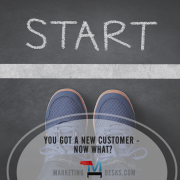5 Ways to Woo Customers Back When They’ve Gone | Customer Retention
Using these five marketing strategies, you can win back some of the customers you thought you lost, revitalize relationships with all your customers and improve client retention rates.

Down but not out: Just because a customer has stopped coming ‘round to your business doesn’t meant that you have lost them for good. Increase client retention rates and bring those lapsed customers back into the fold using these 5 ways to woo customers back when they’ve gone.
Let’s face it, even if nothing has gone wrong (that you know of) in your customer relationships, from time to time every business loses customers. Even customers whose relationships could be characterized not only as loyal but even as brand advocates – for one reason or another – may stop buying your products or services.
Customer churn is costly!
You have probably heard that marketing experts estimate that it costs anywhere from 5-10x more to attract a new client to a business than to retain existing customers. For seven out of ten customers that stopped patronizing a business, the reason they cited was perceived employee indifference.
 But you may not have heard this *tidbit yet: 70% of customers who stopped buying from a service provider due to a product or service defect would not have left, had their problem been resolved immediately (on the first try at resolution). In other words, it wasn’t the problem – it was the poor customer service – that created the customer defection. (Accenture.com, 2012 Global Consumer Pulse Research Key Findings)
But you may not have heard this *tidbit yet: 70% of customers who stopped buying from a service provider due to a product or service defect would not have left, had their problem been resolved immediately (on the first try at resolution). In other words, it wasn’t the problem – it was the poor customer service – that created the customer defection. (Accenture.com, 2012 Global Consumer Pulse Research Key Findings)
You might feel like you don’t have control over when and whether customers decide to stop buying your products or services; however, there are ways you can quickly “close the back door” and work to minimize customer defections from your organization.
Losing Your Audience? Try These 5 Customer Retention Strategies
1. Empower and train employees, especially as it pertains to resolving customer complaints, disputes and requests for information.
Many businesses invest countless hours and a lot of money to train staff on how to process sales transactions, find and deliver inventory and other common business operations. Far fewer invest equal (or enough) time and money in training staff in the interpersonal skills needed to maximize customer satisfaction.
Make sure that your employees have the knowledge necessary and are empowered to provide resolution for customers at the earliest point possible in the customer complaint or problem resolution process.
2. Ask customers what they like – and don’t like – about doing business with you.
Sometimes dissatisfaction starts small and simmers for a while. By periodically assessing the level of satisfaction customers have with your business, you have a much better chance of getting them to tell you if something isn’t working for them. Wouldn’t you rather expend the time and resources to act on a valued customer’s suggestion before they decide to leave?
3. Act on customer suggestions.
Merely asking customers what they like and don’t like is just the beginning. Once you have information you can act on, act on it whenever it is practical and possible to do so. Don’t miss a chance to improve all of your customer relationships by making even small adjustments to various parts of the customer experience. As Walt Disney said, “Little things make the big things happen.”
4. Recognize and reward behavior you want more of.
If your customers are gracious enough to tell you how you can make your business better, and you have acted on their suggestions and done so, don’t forget to thank them! Create a customer “hall of fame” where customer suggestions are noted, along with the actions that you took to implement solutions. Create a program that rewards customer suggestions which are acted on with gift cards. Encourage customers to provide you with valuable intelligence that can help you differentiate your business to gain competitive advantage as well as raise the level of customer satisfaction at your business. And make it super-easy for them to do so!
5. Tell customers you miss them.
Many businesses claim that their customers are “#1” or their highest priority, but rarely do they ask lapsed customers why they stopped coming in or whether there was a problem they neglected to address. Instead, most businesses focus nearly all of their marketing money and resources on attracting new customers to take their place.
When customers are notably absent, shoot them an email or – even better – a personal notecard to say that you have noticed, that they are important to you and that you would love to have them return again soon. Ask why they stopped buying your products or services. Ask if they left for a competitor. Incentivize lapsed customers with exclusive offers or discounts to return.
The worst they can say is no. But by demonstrating through your actions that your customers truly are your highest priority; you stand a much better chance of getting them to return. And if they do return, chances are it will be with a renewed sense of loyalty and brand advocacy for your business, since you proved that customer service was not a cliché at your business.
***
My 2015 Small Business Marketing Calendar is available on amazon.com — in print or digital format. It is absolutely packed with marketing inspiration and a working content marketing plan you can use to attract – engage – retain and motivate your customers in the coming year.







Trackbacks & Pingbacks
[…] churn will happen. Minimizing customer churn is what customer relationship management (or CRM) is all about (or at least it’s supposed to be!) […]
Leave a Reply
Want to join the discussion?Feel free to contribute!